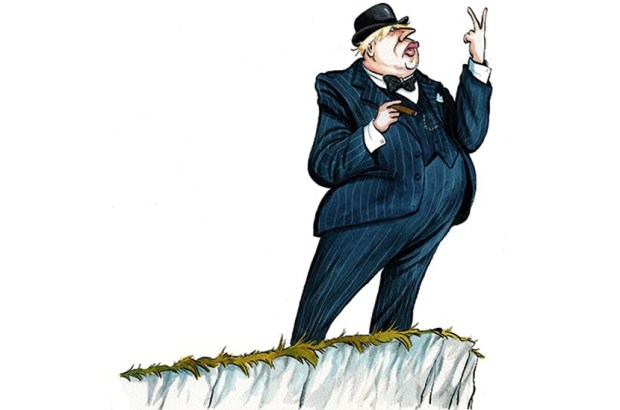The next three months may well prove to be the hardest of the whole pandemic. The new variants of Covid-19 appear to be the wrong type of game-changer. After our national lockdown in March, infection levels started falling because of extreme measures — including closing schools, places of worship and non-essential retail. But the infectiousness of the ‘Kent strain’ suggests that as it becomes prevalent, a new lockdown might be unable to contain it. When ministers first locked down, they did so in the expectation of taming the virus. This time, it’s more in hope.
Boris Johnson didn’t show us any graphs when he announced the latest lockdown. He didn’t need to; the situation is clear. In England, in-patient numbers with Covid are 40 per cent higher than they were in the last peak. More than a million people had the virus between Christmas and the new year, according to the Office for National Statistics, about one person in 50. In London and the south-east, 475,000 had Covid-19: a fourfold increase in the space of a few weeks.
For months now, we have heard about the ‘R number’: the average number of others to whom an infected person passes the virus. For the pandemic to shrink, R needs to be below 1. After the first lockdown, it dropped to 0.7. The latest official estimate puts it between 1.1 and 1.3, hence the current mayhem. A recent Imperial College assessment found that the new Kent strain of Covid-19 increases the R by anything from 0.4 to 0.7 points. It doesn’t take an epidemiologist to work out the implications of this.
If the new strain goes nationwide, and the rest of the country suffers the hospitalisation surges seen in London and the south-east, even the current lockdown will not be enough. The NHS would be overwhelmed and there would be thousands more deaths. It’s not a matter of going back to where we were in March. It’s worse. The NHS faces a higher Covid caseload than ever, on top of its normal winter burden.
But this time, there is one big difference: we have an exit strategy. The Prime Minister said that the NHS hopes to vaccinate all over-70s and the clinically extremely vulnerable by the middle of next month. This will be 13 million people — which by some estimates would mean nine out of every ten of those most at risk of dying from Covid. Quite an ambition. But if it’s achieved, the Prime Minister said, it will allow him to lift ‘many’ of the restrictions. So it’s a race: vaccine against virus.
During the grim months ahead, leading up to Easter, we could go further by administering the first shots to all at-risk groups (NHS staff, those with underlying health conditions, care home residents, and eventually all over-50s). This could, in theory, protect almost everyone at risk of dying from Covid-19. It’s a huge logistical operation with plenty that can go wrong.
As the first major country to roll out the Pfizer and Oxford/AstraZeneca vaccines, Britain has been on the front foot. More people have been vaccinated here than in the rest of Europe put together. But trailblazers tend to be the first to encounter setbacks. We can expect to read about vaccine nationalism, delays in manufacturing the jab, long queues for vaccines, postcode lotteries, or at-risk individuals somehow getting lost in the system. The medical regulator must approve every vaccine batch coming out of the factory, and some may fail the test.
Much depends on how many people in these at-risk groups refuse to take up the vaccine — or cannot receive it for medical reasons. How many do we expect? It could be 5 per cent, around what we have achieved with the measles vaccine for young children. Matt Hancock, the Health Secretary, told this magazine that about one in five pensioners failed to turn up for their flu vaccine last year. Polls suggest a similar proportion will refuse the Covid vaccine now, which, while worrying, is lower than in France, where some polls say 60 per cent do not want the vaccine.
Uptake is crucial. By Easter, we may have offered the first shot to all 25 million at-risk people. But we could still have missed vaccinating up to seven million at-risk people who are unwilling or unable to accept the jab. If so, then daily deaths could still be as high as they are now — perhaps higher. If there are as few as a million at-risk people unvaccinated, the death rate could drop to below 100 a day, which would be lower than in a bad flu season and a figure which could be tolerated.
The Prime Minister talks of the ‘light at the end of the tunnel’, but after we emerge from the multiple lockdowns, that light will reveal some pretty serious problems. Our economic position will be grim, with more lockdown-induced misery inflicted. Only when the furlough scheme ends will we see how high unemployment is set to rise — perhaps above three million. The longer restrictions last, the deeper the permanent damage: the ‘scarring’, as Rishi Sunak calls it.
Hence the case for easing Covid restrictions early. Most of us have become sick of all the constraints and would give a lot to return to normal. A return by Easter to a situation approaching normality could unleash a wave of growth as consumers spend the savings they have built up. It could save companies (including bars and restaurants) that are teetering on the brink. It could create new jobs and stem the job losses. But it might also rekindle the virus. We can expect a heated debate.
The case for a slower relaxing of restrictions will be about protecting the unvaccinated. While the vaccine seems to be excellent at reducing severe illness, we don’t know how effective it is at suppressing infection. So it is possible that vaccinated people could still infect others (as of course could unvaccinated people). If the restrictions are abolished quickly, we could see infection rates of the new variant grow to far higher than the current level. But it’s argued that will still mean far fewer hospitalisations and deaths, since the most at-risk will have had their shots by the middle of next month. So it may be safe to unlock and (as Hancock puts it) cry freedom.
The challenge to this is obvious: do ministers really propose — in their words — ‘letting the virus rip’ among the young? Covid affects all ages: at one stage, half of those admitted to hospital with the virus were under 65. Then there’s long Covid, where symptoms can last for months. If you add to this a serious death toll (perhaps still in the hundreds) from the at-risk groups who for whatever reason didn’t get the vaccine, then you still have a serious Covid problem at Easter even if vaccination continues as planned.
We can mitigate the risk by doing five things. First, we need to source and administer vaccines at the required pace. We will need to average more than two million shots a week to vaccinate 25 million in the 12 weeks before we have to start administering the second shots. That’s the biggest and most obvious challenge.
Second, we need to vaccinate as many of the at-risk as possible. Hitting 95 per cent penetration could be a huge challenge. Does the NHS have up-to-date contact details for all of this group? Or experience in persuading the sceptical? We need a system to track those who decline the invitation of a vaccine, to understand and allay their fears. Ministers have ruled out either compulsion (as is deployed with seat belts) or vaccine certification (which could, in theory, be required for people to travel or attend mass events). A lot, then, rests on persuasion.
Third, we need to continue making progress on treatments, both pharmaceutical and clinical. Since the start of the pandemic we have roughly halved the proportion of individuals who are admitted to hospitals with Covid and die of it — partially as a result of better treatments, such as dexamethasone, and clinical practices such as the use of the prone position. We have a potentially exciting pipeline of treatments in ‘urgent public healthcare status’ trials (full disclosure: I have invested in a number of these innovators). These trials need publicity to encourage enrolment.
Fourth, we need to understand better the risk of long Covid. It’s not a freak condition. A recent ONS survey suggested that as many as one in ten Covid patients still had symptoms after three months. It’s wrong to measure Covid only in terms of death vs survival rate: it can knock people out for months. If a relaxation of lockdown results in an explosion of infection rates, we need to understand the full implications of this under-discussed condition.
Finally, we need to be even more vigilant about monitoring globally for variants, especially those that would require a new vaccine. As we vaccinate more, the virus has more natural selection pressure to evolve into a vaccine-resilient variant. Despite the UK’s much-admired genomic surveillance capability, we let our homegrown Kent variant spread around the UK and world. Paradoxically, we were better with the recently discovered South African variant, stopping all flights. We need to learn from this and become much better at responding, adopting a ruthless isolation process when future variants occur.
It is still possible that 2021 will be the start of a return to normal. But there is a long line of ifs. If we can ensure delivery. If we can ensure a very high take-up among those at risk. If we can continue to develop treatments and respond to variants. Vaccines could start a return to normal life, perhaps even as soon as next month. But there is a lot that needs to go right.
Got something to add? Join the discussion and comment below.
Get 10 issues for just $10
Subscribe to The Spectator Australia today for the next 10 magazine issues, plus full online access, for just $10.
You might disagree with half of it, but you’ll enjoy reading all of it. Try your first month for free, then just $2 a week for the remainder of your first year.














Comments
Don't miss out
Join the conversation with other Spectator Australia readers. Subscribe to leave a comment.
SUBSCRIBEAlready a subscriber? Log in